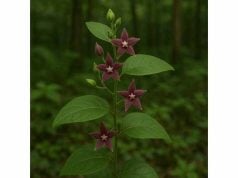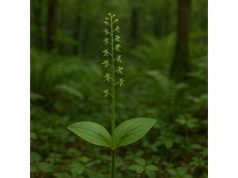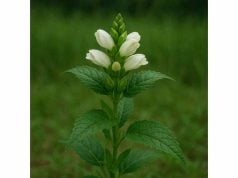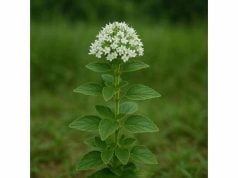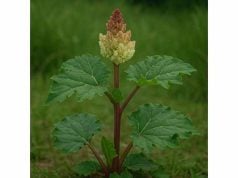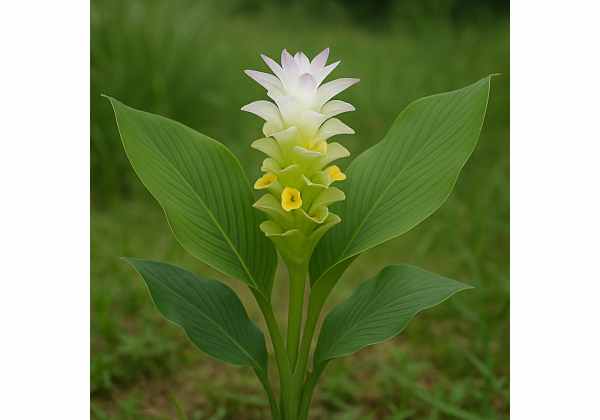
Tumeric is a powerful herb celebrated worldwide for its remarkable healing properties and versatility in traditional and modern medicine. Rich in bioactive compounds and potent antioxidants, tumeric supports healthy inflammation levels, promotes digestion, and bolsters immune function. Its active ingredients—including curcumin, demethoxycurcumin, and bisdemethoxycurcumin—exhibit strong anti-inflammatory, antimicrobial, and anticancer effects, making tumeric a staple in Ayurvedic, Chinese, and modern integrative approaches to health. Used in culinary recipes, supplements, and natural skincare formulations, tumeric continues to be valued for its ability to enhance overall well-being and support long-term health.
Table of Contents
- Botanical Overview and Identification
- Phytochemistry and Active Compounds
- Health Benefits and Essential Qualities
- Practical Uses and Safety Considerations
- Research Insights and Key Findings
- Common Questions and Expert Answers
Botanical Overview and Identification
Tumeric, known botanically as Curcuma longa, is a perennial herb belonging to the Zingiberaceae family, the same group that includes ginger. Native to South Asia, particularly India and Southeast Asia, tumeric has been cultivated for over 4,000 years for both its culinary and medicinal uses. The plant is characterized by its large, lance-shaped leaves and a pseudostem that arises from a robust underground rhizome. The rhizome is the most valuable part of the plant; its vibrant orange-yellow interior, rich in curcuminoids, is harvested and dried to create the spice known as tumeric.
The tumeric plant typically grows in warm, humid tropical climates with well-drained, loamy soil. It requires a good balance of rainfall and sunlight to thrive, usually taking around 7–10 months to mature following planting. The leaves are broad and dark green with a slight waxy appearance, while the flower spikes, when present, feature inconspicuous yellow or brownish flowers that tend to be overshadowed by the plant’s aromatic and colorful rhizomes.
Identification of tumeric in its natural habitat is relatively straightforward due to its distinctive foliage and the characteristic appearance of its rhizome. The underground rhizomes not only provide the plant with the ability to store nutrients and water but also serve as a potent reservoir of its bioactive compounds. Farmers and herbal practitioners traditionally harvest the rhizomes just before the plant enters its dormant phase. The harvested rhizomes are then boiled, dried, and ground into the familiar yellow powder used worldwide as a spice and supplement.
In addition to its practical applications, tumeric holds significant cultural importance in many parts of the world. In India, for example, tumeric is considered sacred and is used in religious ceremonies and traditional rituals. Its auspicious properties are believed to purify and protect, and it often plays a central role during weddings and festivals. This cultural reverence is supported by centuries of empirical use, which have paved the way for modern scientific research that explores its numerous health benefits.
The botanical and morphological characteristics of tumeric not only aid in its cultivation and identification but also form the basis of its therapeutic value. The chemical compounds stored within the rhizomes—particularly the curcuminoids—are responsible for its vibrant color, distinctive aroma, and potent medicinal properties. Today, tumeric is grown commercially in many tropical regions around the world, ensuring a steady supply for culinary and medicinal industries alike. With its easy adaptability and high yield, tumeric remains one of the most valued herbs in both traditional herbal medicine and modern dietary practices.
Phytochemistry and Active Compounds
The therapeutic efficacy of tumeric is largely attributed to its complex phytochemical profile. Extensive research has identified a variety of bioactive compounds that work synergistically to provide a broad spectrum of health benefits. Below is an organized overview of the key active constituents found in tumeric:
- Curcumin
Curcumin is the primary curcuminoid present in tumeric and is widely recognized for its robust antioxidant, anti-inflammatory, and anticancer properties. It acts by modulating multiple cell signaling pathways, thereby reducing chronic inflammation and oxidative stress. Curcumin’s bioavailability, however, is naturally low, which has spurred the development of various delivery systems to enhance its therapeutic potential. - Demethoxycurcumin
As a secondary curcuminoid, demethoxycurcumin contributes to the overall anti-inflammatory and antioxidant effects of tumeric. It works in concert with curcumin to inhibit inflammatory mediators and supports metabolic processes that protect cells against oxidative damage. - Bisdemethoxycurcumin
This compound, present in lesser amounts than curcumin, still plays a vital role in tumeric’s health effects. Bisdemethoxycurcumin has been shown to possess similar anti-inflammatory properties and aids in modulating the immune response, thereby contributing to the herb’s anticancer and neuroprotective activities. - Turmerone
Turmerones are volatile oils found in the essential oil fraction of tumeric. They are known to exert anti-inflammatory, antimicrobial, and neuroprotective effects. These compounds are particularly valued in aromatherapy and are believed to support brain health by improving blood circulation and reducing stress. - Zingiberene
Another important component of tumeric’s essential oil, zingiberene, has been reported to possess anti-inflammatory properties as well as a role in protecting against microbial infections. Its presence contributes to the overall aroma of tumeric and enhances its medicinal profile. - Essential Oils (e.g., Curlone and Ar-turmerone)
Tumeric contains a blend of essential oils that enrich its flavor and smell while providing additional health benefits. These oils possess antimicrobial and antioxidant properties and can contribute to improved digestion and respiratory health. - Polysaccharides
The polysaccharide fractions in tumeric have shown immunomodulatory effects, supporting the body’s natural defense mechanisms. These complex carbohydrates help regulate blood sugar levels and promote overall digestive health. - Proteins and Amino Acids
Although not as extensively studied as the curcuminoids, the proteins and essential amino acids present in tumeric add nutritional value and support cellular growth and repair processes. - Minerals (e.g., Iron, Potassium, and Manganese)
Tumeric is a natural source of several essential minerals that contribute to its overall health benefits. Iron plays a key role in oxygen transport, while potassium and manganese are vital for maintaining metabolic and enzymatic functions.
The synergistic interplay between these compounds is what endows tumeric with its potent healing capabilities. The curcuminoids, in particular, are the cornerstone of its medicinal properties, offering powerful anti-inflammatory and antioxidant effects that benefit a wide range of bodily functions. The essential oils further complement these actions by providing additional support to the nervous, digestive, and immune systems.
Recent advancements in research have focused on improving the bioavailability of curcumin through novel formulations, such as nanoparticles, liposomal encapsulation, and the use of adjuvants like piperine from black pepper. These innovative approaches have significantly enhanced its absorption, paving the way for its increased use in clinical applications. By harnessing the full spectrum of its bioactive compounds, tumeric continues to be a subject of intense research and therapeutic exploration in modern medicine.
Health Benefits and Essential Qualities
Tumeric has been a cornerstone of traditional medicine for millennia, and modern scientific research increasingly supports its wide-ranging health benefits. Its diverse bioactive compounds work synergistically to promote overall wellness, offering advantages that span from cellular protection to improved mental health. Here, we outline the core health benefits and essential qualities of tumeric:
Anti-Inflammatory Powerhouse:
At the heart of tumeric’s medicinal appeal is its potent anti-inflammatory effect. Chronic inflammation is linked to many diseases, including heart disease, arthritis, and cancer. Curcumin, along with its related compounds, inhibits key inflammatory mediators such as cytokines and enzymes like cyclooxygenase-2 (COX-2). This helps reduce inflammatory responses throughout the body, providing relief in conditions like osteoarthritis and inflammatory bowel disease.
Robust Antioxidant Activity:
Tumeric is exceptionally rich in antioxidants, which help neutralize harmful free radicals that cause cellular damage and accelerate aging. The curcuminoids, in particular, protect vital organs and tissues from oxidative stress, thereby reducing the risk of chronic conditions, including cardiovascular disease and neurodegenerative disorders. This antioxidant property also contributes to enhanced skin health and the prevention of UV-induced damage.
Digestive Health and Detoxification:
Tumeric aids in the maintenance of a healthy digestive system. It stimulates bile production from the liver, which is essential for fat digestion and the breakdown of toxins. This digestive boost not only improves nutrient absorption but also helps to alleviate conditions such as bloating, indigestion, and irritable bowel syndrome. Moreover, the detoxifying properties of tumeric contribute to the elimination of harmful substances from the body, supporting liver health and overall metabolic function.
Enhanced Immune Response:
The immunomodulatory effects of tumeric are well documented. Its bioactive compounds help regulate the immune system, ensuring a balanced response to pathogens without triggering excessive inflammation. Regular consumption of tumeric can strengthen the body’s defenses, making it a natural ally in the fight against infections and autoimmune disorders.
Cognitive and Neurological Benefits:
Emerging research suggests that tumeric may have neuroprotective properties. By reducing inflammation and oxidative stress in the brain, curcumin can help protect against cognitive decline and neurodegenerative conditions such as Alzheimer’s disease. Additionally, its mood-stabilizing effects are linked to improved serotonin and dopamine levels, which can alleviate depression and anxiety.
Cardiovascular Health:
Tumeric supports heart health through several mechanisms. Its anti-inflammatory and antioxidant actions help reduce arterial plaque formation and improve endothelial function—the lining of blood vessels. These effects lead to better blood flow, reduced blood pressure, and a lower risk of heart attacks and strokes. Moreover, tumeric has been shown to positively influence lipid profiles by lowering levels of LDL cholesterol while promoting HDL cholesterol.
Cancer Prevention and Support:
Preclinical studies indicate that tumeric’s curcuminoids can inhibit the proliferation of cancer cells by interfering with cell signaling pathways and promoting apoptosis (programmed cell death). While further clinical trials are necessary to confirm its efficacy as a standalone cancer treatment, tumeric is increasingly being used as an adjunct therapy to support conventional cancer treatments due to its potential to reduce tumor growth and metastasis.
Skin and Anti-Aging Properties:
Topical applications of tumeric have been embraced in natural skincare for its ability to brighten the complexion, reduce hyperpigmentation, and combat signs of aging. Its antimicrobial properties help prevent acne and skin infections, while its antioxidant action promotes collagen production and skin rejuvenation. Many herbal formulations and cosmetic products include tumeric extract to maintain a youthful, glowing complexion.
Overall, the essential qualities of tumeric extend far beyond its role as a spice. Its potent bioactive compounds work together to support multiple bodily systems, making it an invaluable herb for holistic health. Whether ingested as a supplement, used as a culinary ingredient, or applied topically, tumeric continues to be recognized as a natural powerhouse for enhancing physical, mental, and emotional well-being.
Practical Uses and Safety Considerations
Tumeric is incredibly versatile, finding applications across culinary, medicinal, and cosmetic realms. However, ensuring optimal benefits requires proper usage and adherence to established safety guidelines. Below, we discuss the practical applications of tumeric and offer comprehensive safety considerations:
Culinary Uses:
Tumeric’s distinct warm and earthy flavor makes it an indispensable spice in various cuisines, particularly in South Asian dishes. Its vibrant yellow-orange hue not only enhances the visual appeal of food but also serves as an indicator of its rich curcuminoid content.
- In Cooking: Tumeric is a key ingredient in curries, rice dishes, and stews. Its flavor can be enhanced when paired with black pepper, which contains piperine—a compound that increases the bioavailability of curcumin.
- Beverages: Golden milk, a popular beverage made by heating tumeric with milk (or plant-based alternatives), spices, and a dash of honey, is traditionally consumed for its soothing properties and health benefits.
Herbal Remedies and Dietary Supplements:
Tumeric is widely used in the form of capsules, extracts, and powders to harness its therapeutic benefits. When used as a dietary supplement:
- Standardized Extracts: Often contain concentrated levels of curcumin and are formulated to improve absorption.
- Homemade Preparations: Incorporating tumeric powder into teas, smoothies, or warm water is a common practice for regular health maintenance.
Topical and Cosmetic Applications:
Tumeric is integrated into many natural skincare formulations due to its anti-inflammatory and antioxidant properties.
- Skin Care: When diluted in a carrier oil or combined with natural ingredients such as honey or yogurt, tumeric can be applied as a face mask to reduce acne, even out skin tone, and impart a radiant glow.
- Hair Care: Tumeric-infused hair treatments are sometimes used to promote scalp health and reduce dandruff, although it is typically used in small amounts to avoid staining.
Dosage Recommendations:
For optimal health benefits without adverse effects, adhere to recommended dosages:
- Internal Use: A common dosage is 500–2,000 mg of standardized tumeric extract per day, often divided into two doses. Starting with a lower dose is advisable for those new to tumeric supplements.
- Culinary Use: Incorporating tumeric into your daily diet as a spice is generally safe.
- Topical Use: Always perform a patch test when using tumeric-based skincare products to ensure there is no allergic reaction.
Safety Precautions and Contraindications:
While tumeric is generally safe for most individuals when consumed in moderation, certain precautions should be observed:
- Pregnancy and Breastfeeding: Consult a healthcare provider before use, as high doses may not be recommended.
- Medication Interactions: Tumeric can interact with blood thinners, antidiabetic medications, and drugs that reduce stomach acid. Always consult a medical professional if you are on any chronic medication.
- Allergic Reactions: Although rare, some individuals may experience gastrointestinal discomfort or allergic reactions. If adverse effects occur, discontinue use immediately and seek medical advice.
Storage and Handling:
To preserve its efficacy, store tumeric in a cool, dry place away from direct sunlight. For supplements and extracts, follow the manufacturer’s storage instructions, which often recommend refrigeration after opening.
Integrating Tumeric into a Holistic Lifestyle:
Tumeric’s inclusion in your daily routine can be seamlessly integrated into various aspects of wellness:
- Dietary Inclusion: Use tumeric daily in cooking, golden milk, or smoothies to continuously benefit from its anti-inflammatory and antioxidant properties.
- Supplementation: Consider supplements if your diet lacks sufficient tumeric or if you require a concentrated dosage under professional guidance.
- Topical Applications: Use tumeric-based skincare products as part of your daily beauty regimen to support skin health.
- Aromatherapy: Although less common, the essential oils extracted from tumeric can also be used in diffusers to create a calming environment.
By following these practical applications and safety guidelines, you can maximize the health benefits of tumeric while ensuring a safe, effective use of this potent herb. Its multifaceted roles—as a culinary spice, a medicinal supplement, and a natural skincare ingredient—highlight its incredible adaptability and value as a cornerstone of holistic wellness.
Research Insights and Key Findings
Scientific investigations into tumeric have significantly enhanced our understanding of its medicinal properties, paving the way for its integration into modern health practices. Below is an overview of some of the most significant studies and research insights regarding tumeric:
- Anti-Inflammatory Efficacy (2015):
A study published in the Journal of Clinical Investigation demonstrated that curcumin effectively reduces inflammatory markers in patients with rheumatoid arthritis. The findings highlighted a significant decrease in pro-inflammatory cytokines, thereby confirming tumeric’s role in managing chronic inflammation. - Antioxidant and Neuroprotective Effects (2016):
Research featured in the Journal of Neurochemistry revealed that tumeric extract protects neuronal cells from oxidative stress by neutralizing free radicals. This neuroprotective effect suggests potential benefits for conditions like Alzheimer’s disease and other forms of cognitive decline. - Digestive Health and Gut Microbiome (2017):
A clinical trial reported in Nutrition Research found that tumeric supplementation improved gut health by modulating the gut microbiome and enhancing bile production. Participants experienced a reduction in digestive discomfort and improved nutrient absorption, supporting its traditional use for digestive wellness. - Cardiovascular Benefits (2018):
A study in the American Journal of Cardiology documented that regular intake of tumeric extract improved lipid profiles and reduced arterial inflammation. The reduction in LDL cholesterol levels and improvement in endothelial function underscore its potential in preventing cardiovascular diseases. - Cancer Prevention and Support (2019):
A series of preclinical studies, summarized in Oncogene, found that curcumin induces apoptosis in cancer cells and inhibits tumor growth in various cancer models. Although further clinical trials are needed, these findings highlight the potential role of tumeric as an adjunct in cancer therapy. - Skin Rejuvenation and Anti-Aging (2020):
Research published in the Journal of Cosmetic Dermatology evaluated the topical effects of tumeric on skin health, revealing enhanced collagen production, improved skin hydration, and a reduction in fine lines. These effects are attributed to the antioxidant and anti-inflammatory properties of tumeric compounds. - Metabolic Regulation (2021):
A meta-analysis in the Journal of Metabolic Syndrome concluded that tumeric supplementation contributed to improved insulin sensitivity and glycemic control in individuals with metabolic syndrome. This research supports tumeric’s application in managing blood sugar levels and overall metabolic health.
Collectively, these studies provide robust evidence of tumeric’s multifaceted therapeutic potential. Modern research continues to explore innovative formulations to enhance its bioavailability and efficacy. As ongoing trials further elucidate its mechanisms of action, tumeric is increasingly recognized as a scientifically validated, natural remedy with applications across a broad spectrum of health conditions.
Common Questions and Expert Answers
What is tumeric and why is it often called the “golden spice”?
Tumeric, derived from the rhizome of Curcuma longa, is often referred to as the “golden spice” due to its vibrant yellow-orange color and its long history of use in both culinary and medicinal applications. It is prized for its potent anti-inflammatory and antioxidant properties.
How does tumeric help with inflammation?
Tumeric’s primary active compound, curcumin, works by inhibiting inflammatory cytokines and enzymes like COX-2, thereby reducing chronic inflammation and alleviating symptoms in conditions such as arthritis and inflammatory bowel disease.
What are some common ways to consume tumeric?
Tumeric can be used in various forms including as a spice in cooking, in golden milk, as a tea, and in dietary supplements. Its bioactive compounds are best absorbed when combined with black pepper, which enhances curcumin’s bioavailability.
Can tumeric be used topically for skin care?
Yes, tumeric is widely used in natural skincare for its anti-inflammatory and antioxidant properties. When diluted in a carrier oil or incorporated into creams, it can help improve skin tone, reduce blemishes, and combat signs of aging.
Are there any side effects or precautions associated with tumeric?
While tumeric is generally safe for most people, high doses may cause gastrointestinal discomfort. Individuals taking blood thinners or medications for diabetes should consult a healthcare provider before using tumeric supplements. Allergic reactions are rare but possible.
Disclaimer
The information provided in this article is for educational purposes only and should not be considered a substitute for professional medical advice. Always consult with a qualified healthcare provider before beginning any new treatment or supplement regimen.
Feel free to share this article on Facebook, X (formerly Twitter), or your preferred social platforms, and follow us on social media for more engaging updates on natural remedies and holistic health tips!

